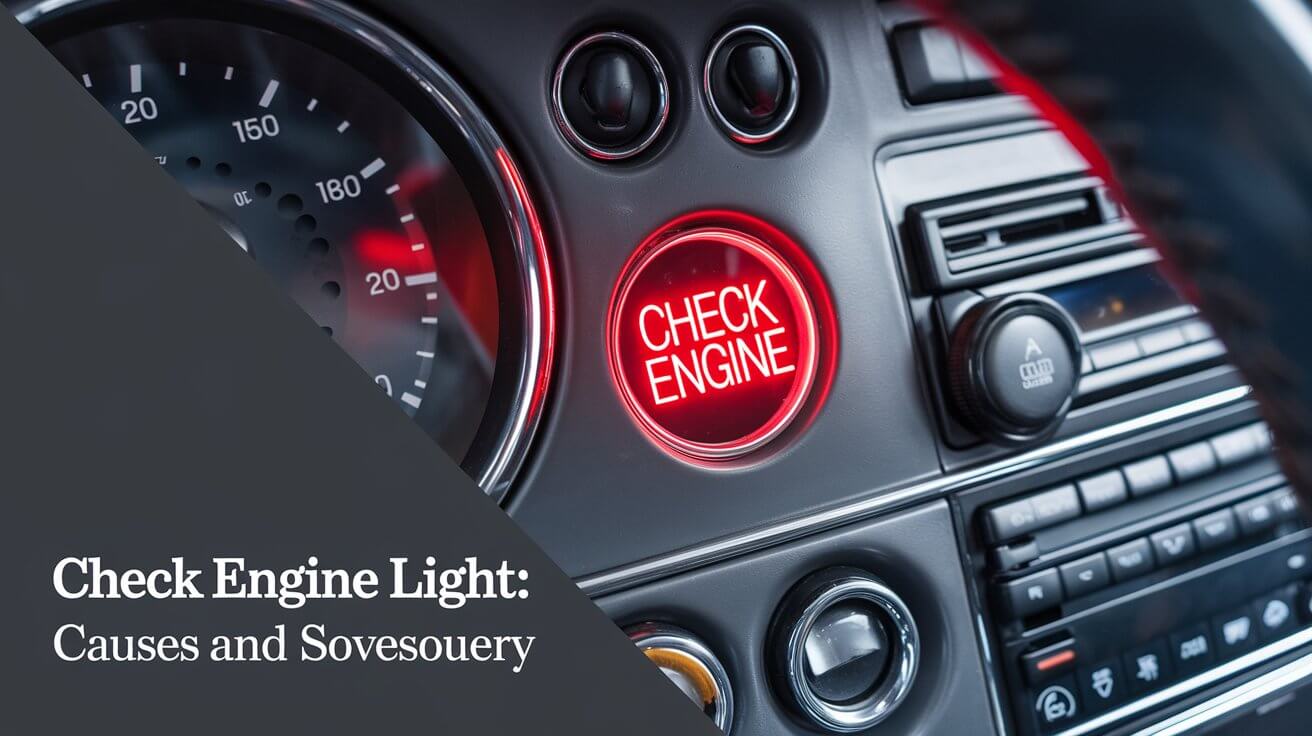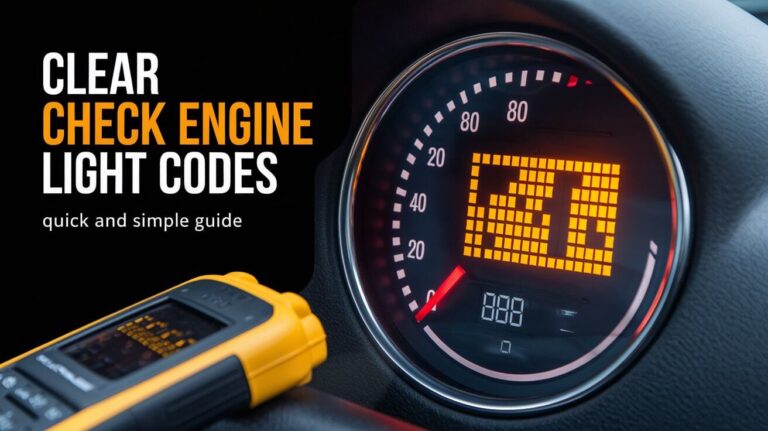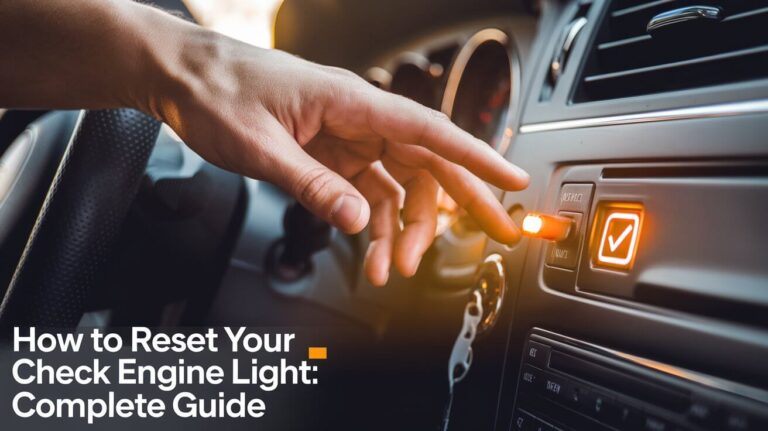What Does the Check Engine Light Mean? Causes and Solutions

When that little check engine light (CEL) on your dashboard illuminates, it’s easy to feel a sense of panic. But before you worry too much, it’s essential to understand that the check engine light is an important warning system built into your vehicle. It means the car’s onboard computer has detected an issue with one of its systems, and it could be something as simple as a loose gas cap or as serious as engine failure.
In this article, we’ll dive into the most common causes behind the check engine light and what you should do if it comes on. We’ll also explore whether it’s safe to keep driving, how you can diagnose the issue, and how to prevent it from happening in the future.
Common Reasons for the Check Engine Light to Come On
Loose or Damaged Gas Cap
One of the simplest causes of the check engine light turning on is a loose or damaged gas cap. A loose gas cap can cause fuel vapors to leak from the tank, which triggers the light. Tightening the gas cap often resolves this issue within a few drives. If the cap is damaged, it’s a cheap and easy replacement.
Faulty Oxygen Sensor
The oxygen sensor monitors the amount of unburned oxygen in the exhaust system and helps regulate the fuel-to-air ratio in your engine. When the oxygen sensor fails, it can cause the engine to burn more fuel than necessary, leading to poor fuel economy. If ignored, a faulty oxygen sensor can also damage the catalytic converter, leading to even more costly repairs.
Catalytic Converter Issues
The catalytic converter is responsible for reducing harmful emissions from your vehicle. If it’s failing, you might notice reduced performance, bad fuel economy, and a sulfur-like smell from the exhaust. Ignoring catalytic converter problems can lead to further engine damage, and it’s an expensive part to replace.
Worn Spark Plugs or Plug Wires
Spark plugs ignite the fuel in your engine, and over time, they can wear out, causing misfires. If your car’s spark plugs or wires are damaged, the check engine light will likely come on, and you might notice reduced engine performance, rough idling, or poor acceleration.
Mass Airflow Sensor (MAF) Problems
The MAF sensor measures the amount of air entering the engine to ensure the correct fuel-to-air ratio. When the sensor malfunctions, it can cause the engine to run too lean (not enough fuel) or too rich (too much fuel). Symptoms of a faulty MAF sensor include stalling, rough idling, and difficulty starting the vehicle.
Low Oil Pressure or Low Oil Level
If your car’s oil level is too low, or if the oil pressure drops, the check engine light may turn on. This could indicate that the engine isn’t getting the proper lubrication it needs, which can cause severe engine damage. It’s crucial to stop driving and check your oil levels immediately to avoid further harm.
Battery Issues
A dead or dying battery can also trigger the check engine light. If your car is struggling to start or if the electrical systems seem off, it might be time to check the battery. Replacing the battery is a relatively simple and inexpensive fix.
Is It Safe to Drive with the Check Engine Light On?
Solid vs. Flashing Check Engine Light
A solid check engine light usually indicates a less urgent issue, like a loose gas cap or faulty oxygen sensor. You may be able to drive your car for a while without causing immediate harm, but it’s still a good idea to have it checked as soon as possible.
A flashing check engine light, on the other hand, indicates a serious problem such as an engine misfire. Driving with a flashing CEL can cause significant damage to your car’s engine or catalytic converter. In these cases, it’s best to pull over and seek help immediately.
When It’s Safe to Drive
If the issue is minor, such as a loose gas cap or old spark plugs, you may be able to drive for a short time without any immediate danger. However, you should monitor your vehicle’s performance and keep an eye out for unusual sounds or behavior.
When to Stop Driving Immediately
If the check engine light is flashing or if your car shows signs of serious trouble like stalling, overheating, or severe loss of power, you should stop driving immediately. Continuing to drive in these conditions can lead to costly damage to your engine or transmission.
What to Do When the Check Engine Light Comes On
Basic Steps to Diagnose the Issue
- Tighten the Gas Cap: If you notice the light after refueling, the gas cap might be loose. Tighten it and see if the light turns off after a few trips.
- Check the Oil Level: Low oil can trigger the check engine light. Check the dipstick to ensure the oil is at the proper level.
- Use an OBD2 Scanner: If you’re familiar with DIY car repairs, you can use an OBD2 scanner to read the diagnostic trouble codes (DTCs). These codes will give you an idea of what’s wrong with your car.
When to Visit a Mechanic
While some minor issues can be resolved on your own, other problems require professional attention. If your car has serious performance issues, or if you’re not comfortable diagnosing the problem yourself, it’s best to take the vehicle to a mechanic. They’ll use specialized tools to pinpoint the issue and recommend the necessary repairs.
Common Diagnostic Trouble Codes (DTCs) Related to the Check Engine Light
P0300 Series: Engine Misfire Detected
Misfire codes can be triggered by various issues such as faulty spark plugs, ignition coils, or fuel injectors. You might experience a rough idle, loss of power, or hesitation during acceleration.
P0420: Catalytic Converter Efficiency Below Threshold
This code is related to the efficiency of the catalytic converter. If the converter isn’t functioning properly, it may result in increased emissions and reduced engine performance.
P0171 and P0174: Fuel System Too Lean
These codes indicate that the fuel mixture is too lean, meaning there’s too much air and not enough fuel. This can be caused by vacuum leaks, a faulty MAF sensor, or clogged fuel injectors.
Preventing the Check Engine Light from Coming On
Regular Maintenance
The best way to prevent the check engine light from coming on is through regular vehicle maintenance. This includes timely oil changes, replacing air filters, and ensuring that spark plugs and other critical components are in good condition. Keeping up with the manufacturer’s recommended maintenance schedule will help keep your vehicle running smoothly.
Using High-Quality Fuel and Parts
Using low-quality fuel or aftermarket parts can lead to problems with your car’s engine and exhaust systems. It’s best to stick to high-quality fuel and OEM parts to avoid unnecessary wear and tear on your vehicle.
Monitor Your Car’s Health
Modern technology allows drivers to monitor their car’s health with OBD2 scanners and apps that can detect problems early on. These tools can alert you to issues before the check engine light even comes on, helping you avoid costly repairs down the line.
The Future of the Check Engine Light: Advancements in Diagnostics
New Technologies in Diagnostics
As vehicles become more advanced, so do their diagnostic systems. In the near future, cars will likely feature enhanced telematics systems that can diagnose problems remotely and even update the driver in real-time via a smartphone app.
Predictive Maintenance
AI and machine learning are making their way into the automotive world, enabling predictive maintenance systems that can identify issues before they cause damage. These systems will help drivers stay proactive about their car’s health and reduce the likelihood of unexpected breakdowns.
Frequently Asked Questions About the Check Engine Light
Can I Reset the Check Engine Light Myself?
Yes, you can reset the check engine light using an OBD2 scanner, but it’s important to address the root cause of the problem before resetting the light. Ignoring the issue won’t make it go away, and it could lead to more severe problems down the line.
Why Is My Check Engine Light Flashing?
A flashing check engine light indicates a severe issue, usually related to engine misfires or overheating. Continuing to drive in this situation can cause significant damage, so it’s essential to pull over and address the problem immediately.
Can Low Fuel Trigger the Check Engine Light?
While it’s uncommon, low fuel can sometimes trigger the check engine light, especially if the fuel system is compromised. It’s a good idea to keep your fuel tank at least one-quarter full to avoid this.
Will the Check Engine Light Turn Off by Itself?
In some cases, the check engine light may turn off on its own after a few driving cycles, especially if the problem was minor (like a loose gas cap). However, if the light stays on, you should investigate further to ensure there’s no ongoing issue.
How Much Does It Cost to Fix Check Engine Light Problems?
The cost of fixing a check engine light issue can vary significantly depending on the problem. A simple fix like tightening the gas cap might cost nothing, while replacing a catalytic converter can set you back several thousand dollars. On average, common repairs like replacing spark plugs or an oxygen sensor can range from $100 to $500.
Conclusion
In summary, the check engine light is a crucial indicator of potential problems with your vehicle. While it can signal anything from a loose gas cap to a serious engine issue, it’s important not to ignore it. Regular maintenance, using high-quality parts, and staying proactive about your car’s health can help prevent the check engine light from coming on in the first place. If it does light up, take the necessary steps to diagnose and address the issue promptly to avoid further damage.


